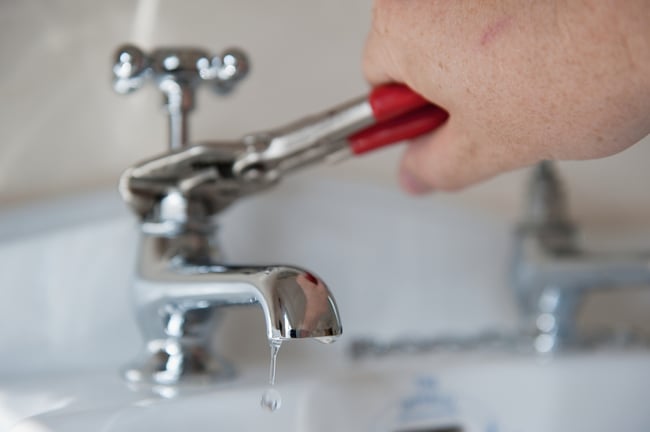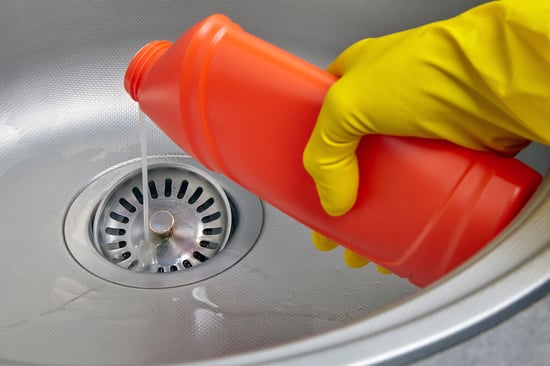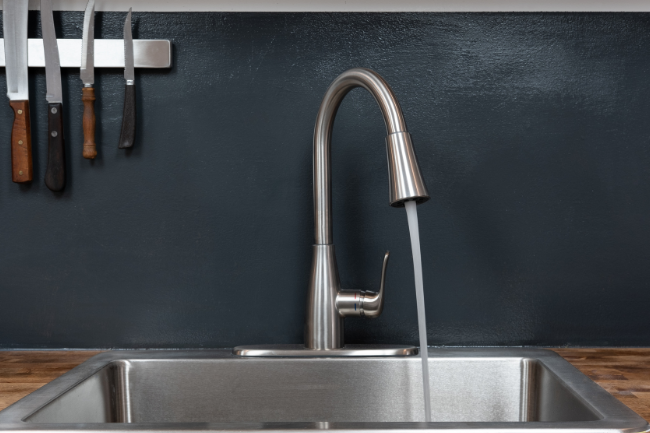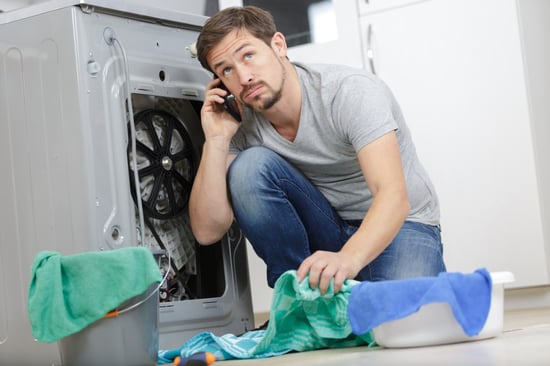Leaky Faucet, Running Toilet, & Clogged Drain Pipes: What You Need to Do
Posted by William Heinselman on

Whenever you're faced with a plumbing problem, it's always in your best interest to contact a professional plumbing contractor. However, when that's just not an option for you, or when the issue is relatively easy to fix, you can opt to handle the project DIY-style.
Here's a closer look at some common pipe problems and some of the standard methods for fixing them on your own.
Understanding Common Pipe Problems
Sooner or later, you're going to encounter a problem with the pipes in your house. Whether it's from old materials that are deteriorating, clogs, or broken fixtures, it's important to understand what the problem is.
One common issue is a leaky faucet. A slow drip might not seem like an issue at first, but soon you'll notice a bigger water bill than normal. Dripping faucets might be tied to misaligned parts, loose screws, cracks within the faucet, or internal blockages.
Another common issue is a running toilet. Not only can the constant sound of a running toilet be annoying, but it can also mean wasted water. In fact, a running toilet can contribute to about 22 gallons of wasted water every day. Frequently, running toilets are caused by misaligned overflow tubes, flush valves, or fill valves.
A third issue you might come across is a clogged drain, which is exactly what it sounds like. Clogged drain pipes might be related to excess food waste in your kitchen sink or too much hair in your shower drain.
If these issues aren't addressed appropriately, they could lead to bigger problems. For instance, A clogged drain could mean excess buildup within the pipe, ultimately leading it to break or burst. Before you know it, there's water seeping into the floors, providing a perfect home for mold to grow. Luckily, these problems can be resolved with simple fixes, so you won't need to be concerned about long-term issues.
What to Do About a Leaky Faucet
Whatever type of faucet you have, before you do anything else, it's vital that you turn off your water running to the faucet. Look for a handle on the wall, where the pipes connect to your sink. All you have to do is twist it clockwise. This will stop the flow of water so you can address the issue without creating bigger problems.
Next, you'll need to know what type of faucet you're working with in order to properly resolve the issue.
Compression Faucets
To fix a compression faucet, first remove the nut using a wrench. Underneath is a stem, which is on top of the O-ring. The O-ring itself goes on top of a rubber seat washer. This will usually be the thing giving you leaking issues. All you have to do is pull the stem out, exposing O-ring and the seat washer.
Next, remove the seat washer (held in place with a screw), and replace it. Just bring the old one with you to the hardware store, and you'll likely find a matching size. Once you get back home, coat the new part with some grease, and install in back into place. Now all you have to do is reassemble each handle, and any leakage should now be a thing of the past.
Ball Faucets
For a ball faucet, unfortunately, you're going to have to purchase a replacement kit. Ball faucets are a bit more intricate, and some require special tools to get the job done properly.
First, unscrew and remove the handle. Next, using pliers, remove the collar as well as the cap. After that, loosen the faucet cam. This would be very difficult without your replacement kit, but with it, the task shouldn't be hard at all. Then, remove the faucet washer, faucet cam, and the ball. Take off the inlet springs and seals using pliers.
After you've completed that, you're going to need to replace the O-rings. Just cut off the bad ones, and coat the new ones in plumber's grease before installing it. Install new springs, cam washers, and valve seats - which should be included in your replacement kit. Finally, all you need to do is reassemble the handle, and you should be good to go.
Cartridge Faucets
For a cartridge faucet, you're going to want to begin the repair by removing the handle. To do this, unscrew it, and tilt in backwards. Next, take off the retaining clip - it's the round piece of plastic holding the cartridge in place. Subsequently, pull the cartridge so that it stands up straight. When your water is on full blast, this is the position the cartridge should be in.
After that, remove the faucet spout and replace the O-rings. As we've stated before, simply cut off the old ones, and coat the new one in grease prior to installing it. Lastly, reassemble that handle, and you're on your way to a leak-free faucet.
How to Fix a Running Toilet
Running toilets don't really do your home any harm, but the sound they make can be outrageously annoying.
 If you weren't already aware of the basics of how your toilet flushes, here goes:
If you weren't already aware of the basics of how your toilet flushes, here goes:
When you push down the flush level, there's a chain that pulls up a flapper, allowing the full tank of water to pour through the bottom, into the toilet bowl. As the water level drops, the flapper drops and closes the opening. You'll also notice that there's a plastic floating mechanism that drops as the water drains. This mechanism is attached to a valve, which lets water into the tank when the float is down, and stops when the float is up. In the center, you'll also find an overflow tube that drains water out into the bowl if the level gets high enough.
If your toilet happens to be running, flush it, wait a few seconds, then lift the lid and look inside. If the tank is not filling like normal, chances are that the flapper is just stuck open. Often times this can be fixed simply by reaching in and adjusting it with your hand.
Sometimes the chain that holds the flapper is caught on something. If the chain is also causing you trouble, you can easily replace it with a string of dental floss, the same length. You'd be surprised at just how sturdy it is.
Your running toilet can potentially be fixed by adjusting the valve and float. If you pull the float, and it stops the water flow, simply adjust the level of the float so the tank stops filling when the water is about an inch under the top of the overflow tube.
How to Clear Clogged Drain Pipes
There are several super easy things you can do to unclog your drain. Whether it be a kitchen sink drain, a bathroom sink drain, or even a bathtub drain, don't run out an immediately call a plumber; there are many instances in which you can take care of this problem on your own.
The first thing you can do when you're experiencing a clogged drain is to simply run hot water (on high pressure) directly into the drain for a good 10-15 minutes. There's a good chance that the heat, paired with significant water pressure will break up whatever happens to be lodged in the drain. It also doesn't hurt to pour a tiny bit of dish soap down there while the water is running - the soap just might help the process along.

If plain old hot water doesn't do the trick, you need employ a liquid plumbing solution. When purchasing a liquid plumbing solution, don't immediately opt for the big name brands. Although high effective, these solutions are made with a host of hazardous chemicals. Instead, you ought to choose a solution made with more natural elements and one that is better for the environment. Surprisingly you can find solutions like this, which are just as potent as they’re harmful chemically based counterparts.
If the clog is stubborn enough, and a liquid plumbing solution just isn't working, maybe you should try purchasing a drain snake tool from your local hardware store. This is basically a long, flexible metal cord, meant to feed into your drain and pulled back out again, hopefully carrying whatever it is that was clogging your drain. One of the great things about this tool is that it's pretty affordable and simple to use.fordable, and you can use it over and over again.
Still Got a Leaky Faucet, Running Toilet, or Clogged Drain?
If these DIY solutions don't resolve the problem, there's no need to give up hope. Instead, reach out to your local plumbers for help. The reality is, sometimes an issue might be more complex that it seems at first, and that's okay.
Express Sewer & Drain is ready to help Sacramento home owners with all of their plumbing needs. Our team will be there to ensure all pipes are in working order so you can go on about your day without worrying about a larger issue. For plumbing help, give us a call right away!
Topics: Pipe Leaks and Repair, Home Plumbing, Drain Cleaning and Repair







